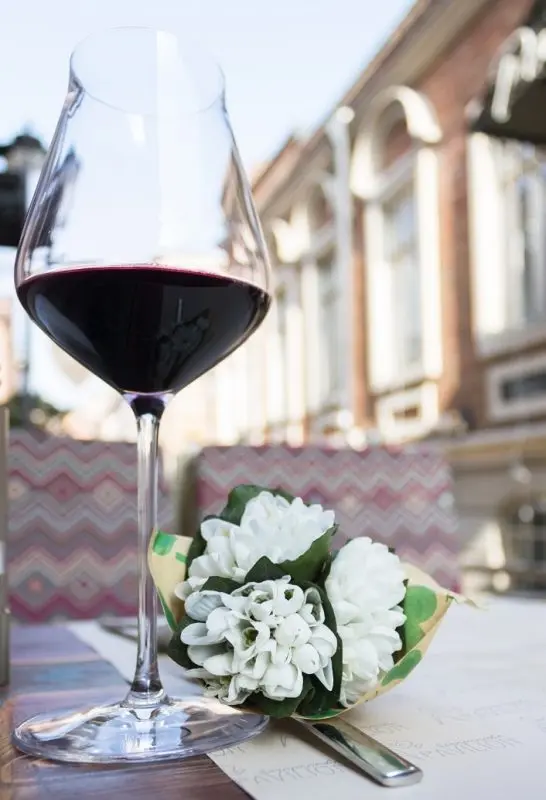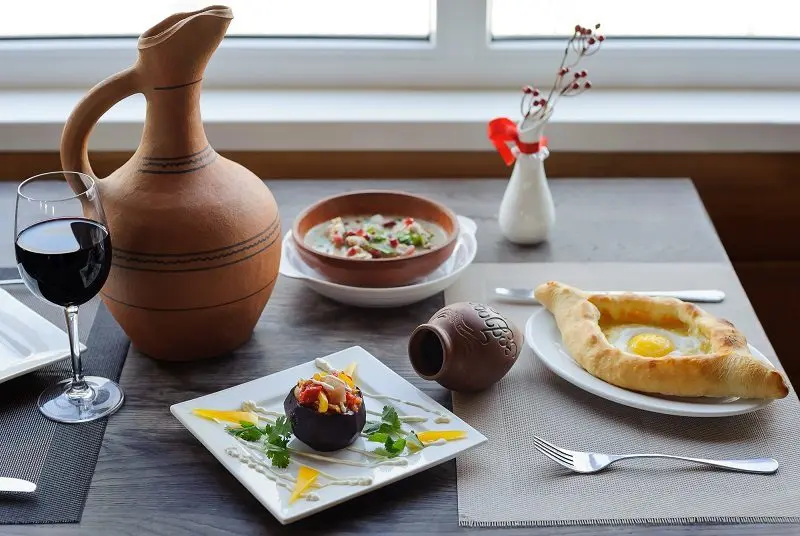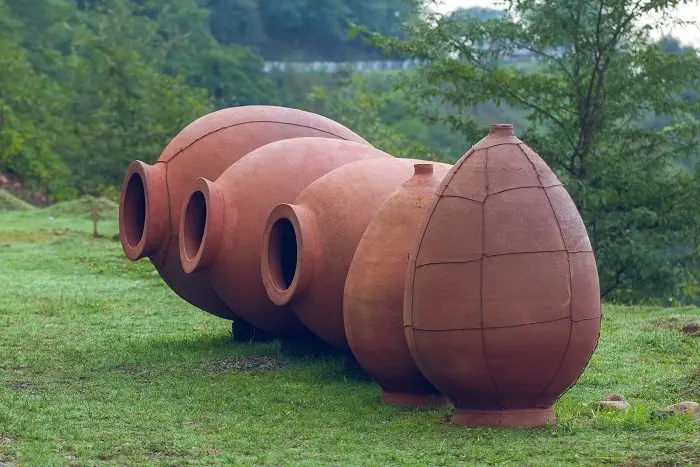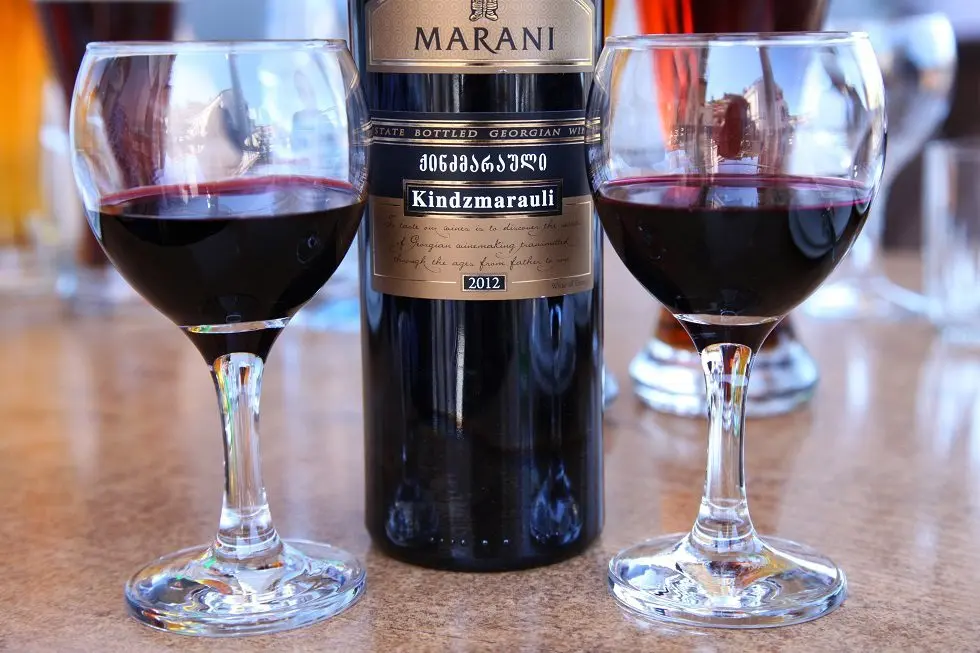Contents
When you hear the names of real Georgian wines, it seems that these brands were created hundreds of years ago. In fact, kindzmarauli is a relatively young wine that appeared in 1942. But the recipe is based on the age-old traditions of oriental winemaking. It is believed that Kindzmarauli, like Khvanchkara, were Stalin’s favorite wines.
Kindzmarauli – Georgian natural semi-sweet (no added sugar) wine with a strength of 10-12 degrees, made from red Saperavi grapes in the Alazani Valley region (Kakheti). The drink has a deep ruby color, moderately viscous, beautifully flows down the walls of the glass. The bouquet of kindzmarauli is full of fruity notes, in which pomegranate, ripe cherries, black currants and apricot stand out.
The taste of Kindzmarauli wines is often described with the epithets “velvety”, “full”, “oily”, “delicate”. Much depends on the individual producer and vintage, but the overall character of the wine remains recognizable.
For the preparation of Kindzmarauli, grapes with a sugar content of 22% or more are used. Fermentation is stopped immediately as soon as the wine gains the desired strength, without waiting for the yeast to process all the sugar in the juice, so the drink remains sweet even without artificial sweetening.
For this brand of wine, only Saperavi grapes are suitable, harvested in the first three weeks of September – not earlier and not later. This variety is considered the “king of grapes”: neat compact clusters of round small berries of deep purple color have a rich taste and aroma. The skin of wine fruits is covered with a thick white coating, and the dark red flesh is filled with tart-sweet juice.

Only a drink made in the Alazani Valley, a small terroir (geographical region) between the Alazan and Duruji rivers, can be considered a real kindzmarauli. During the period of snowmelt, the rivers are filled with mudflows, flood the soil and saturate the grapes with minerals. They say that grapes ripened in this region of Kakheti are not only full of vitamins and microelements, but even contain gold and silver. On this small area of 120 hectares, a unique microclimate has been established, which cannot be recreated in any other place in Georgia or, moreover, in another country.
Kindzmarauli is a name controlled by origin. Georgia has officially registered this brand and has exclusive rights to it.
How and with what to drink kindzmarauli
Kindzmarauli is not a table wine; according to traditions, it is not customary to drink it in large quantities during a feast. For this, carafes of white wine are usually put up, and semi-sweet red goes for dessert.
Before serving, Georgian Kindzmarauli wines are cooled to 10-12°C, this temperature emphasizes the fruity freshness. It is advisable to fill glasses no more than a third in order to capture the characteristic aroma.
In terms of appetizers, kindzmarauli is a versatile wine that goes well with meat dishes, shish kebabs, and grilled ribs. This drink goes well with fruits (cherries, raspberries, strawberries), desserts, and classic wine snacks like nuts and cheeses.

Kindzmarauli will decorate any solemn event, from a wedding to the Constitution Day. But drinking this wine “just like that” is not accepted – this is the pearl of the wine cellar, a festive drink that requires a significant reason.
Features of Kindzmarauli production technology
The original and deep taste is the result of not only the use of a certain grape variety, but also the use of the Kakheti winemaking method. Crushed bunches of Saperavi with combs and pits are kept in special kvevri clay jugs dug into the ground, where the future wine “ripens” at a constant temperature of +14 degrees. Under such conditions, the fermentation process is slow, so Kindzmarauli is kept for two whole years.

Only berries from vineyards over 30 years old are suitable for the “right” wine. Considering that Kindzmarauli is produced in a very limited area, the Saperavi variety is not very prolific and not every vine is suitable for business, it is obvious that this wine belongs to the limited edition category, and there are more fakes on the market than the original product.
Only 60 bottles of Kindzmarauli are exported to Russia a year, and this wine is quite expensive, so if you see the cherished name on an unpretentious bottle from a cheap store, it’s a hundred to one that you have a “fake” in front of you.
How to distinguish a fake kindzmarauli
Semi-sweet wines are often faked – semi-dry ones have a characteristic tart taste that is difficult to imitate with budgetary funds. The main (but not the only) marker of Kindzmarauli’s authenticity is the price. For the reasons already mentioned, this wine is produced in small batches and cannot be cheap, especially considering intermediary margins, transport costs and other factors that increase the already rather high cost.
A more reliable way to understand what kind of wine has fallen into your hands is to carefully study the label. It happens that the name itself is written in large letters, and in front of it is smallly attributed “wine made according to the recipe.” Formally, there is nothing to complain about, but in reality it is a fake, and many buyers “get caught”.
The label of a real vintage kindzmarauli must indicate the name and category, grape variety, producer, sugar and alcohol content (in our case it will be about 12%). Also make sure that you have all excise taxes, certification badges and the year of manufacture.

Finally, turn the bottle upside down and look at the sediment. It is allowed, but insignificant, if the sediment is clearly more than it should be – you probably got a cheap powdered drink in a beautiful bottle, nothing more.









